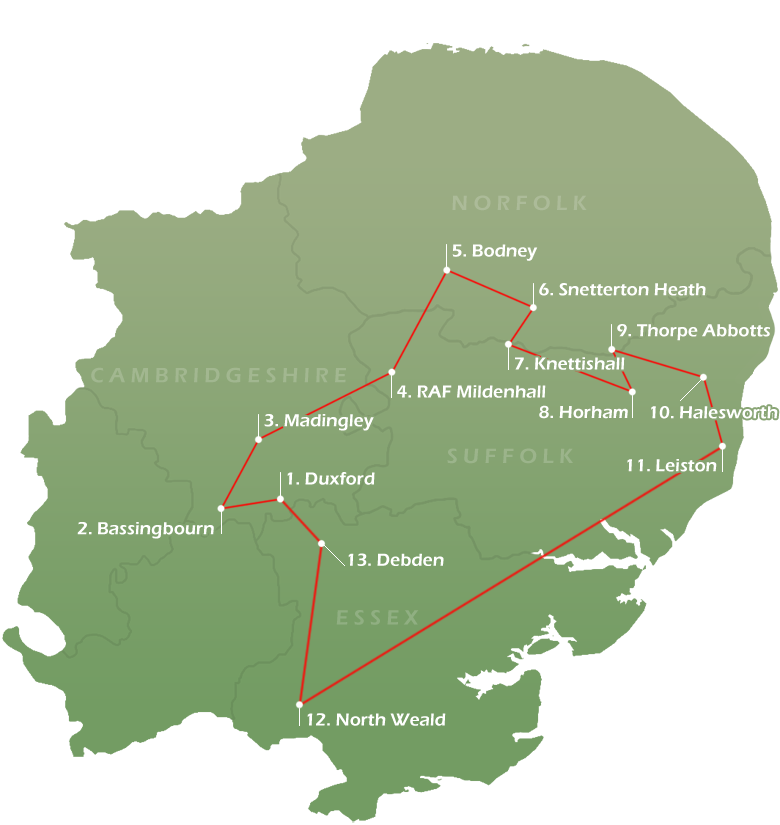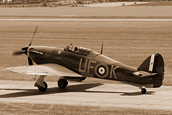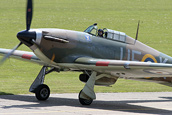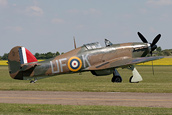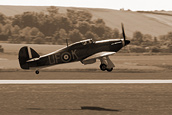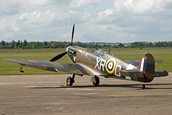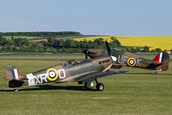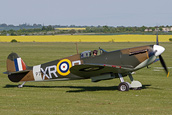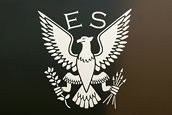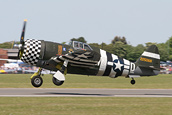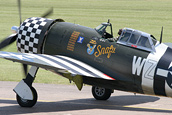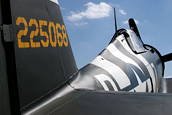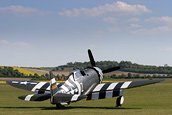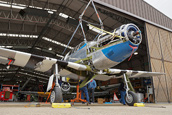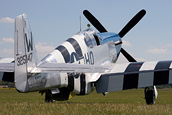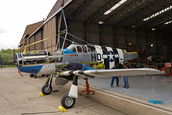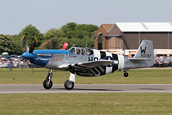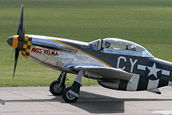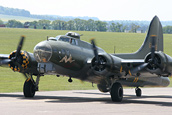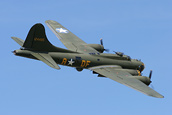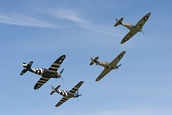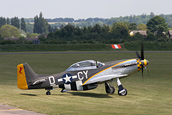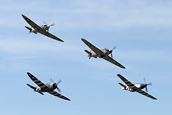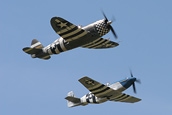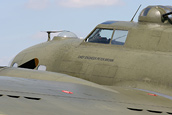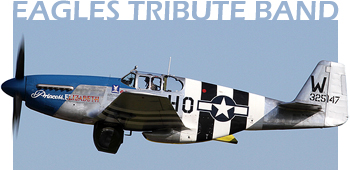
The Eagle Squadron Commemorative Flypast
Monday 27th May 2013
The May Bank Holiday weekend was one of commemoration at IWM Duxford. The Eagle Squadron display team brought together pilots and aircraft from far and wide to mark the passing of 70 years since the arrival at RAF Duxford of the United States Eighth Air Force's 78th Fighter Group. Following an acclaimed performance at the Spring Air Show held on Sunday, the stars of the show took centre stage again on Monday 27th May as they spread their wings further afield, taking in a list of many American Air Force bases, past and present, that are scattered across the East Anglian countryside to mark a significant milestone in the fine style that Duxford is reknowned for.
UKAR's was at IWM Duxford and presents this photo-feature on the aircraft, their wartime pilots and the commemorative flypast. provides supplementary photographs.
The four fighters of the Eagle Squadron encapsulate the tale of American pilots and their involvement both before and after the USA officially entered the war. Volunteer recruits from America were flying both the Spitfire and Hurricane in the Royal Air Force, and were formed into their own units within the RAF. It is from these 'Eagle Squadrons', and in their honour, that the formation team takes its name. The P-51 and P-47 both represent types synonymous with the US Army Air Forces, which were stationed across East Anglia in vast numbers following the attack on Pearl Harbour and the American forces arrival in Europe.
This quartet of Allied fighters not only represent the types flown by American airmen, but the paint schemes adorning each have a significance of their own.
Hawker Hurricane Mk X
Leading the fighter formation across the weekend was Hawker Hurricane Mk X, AE977. This aircraft returned to the UK in 2012 from the Texas, where it had been a part of the Planes of Fame fleet since 2001. It now resides at Biggin Hill as part of the fast-growing stable at the Biggin Hill Heritage Hangar.
For its role in the Eagle Squadron, '977 adorned the colours of P3886, coded UF-K, of 601 (County of London) Squadron, Royal Auxiliary Air Force, an aircraft flown by both William Meade Lindsley "Billy" Fiske III and Carl Raymond Davis.
A graduate of Cambridge University, Fiske twice won Gold at the Winter Olympics of 1928 and 1932 as part of the US Bobsleigh team. One of only eleven American pilots active with Fighter Command during the Battle of Britain, Pilot Officer Fiske was the first to give his life while serving with the RAF.
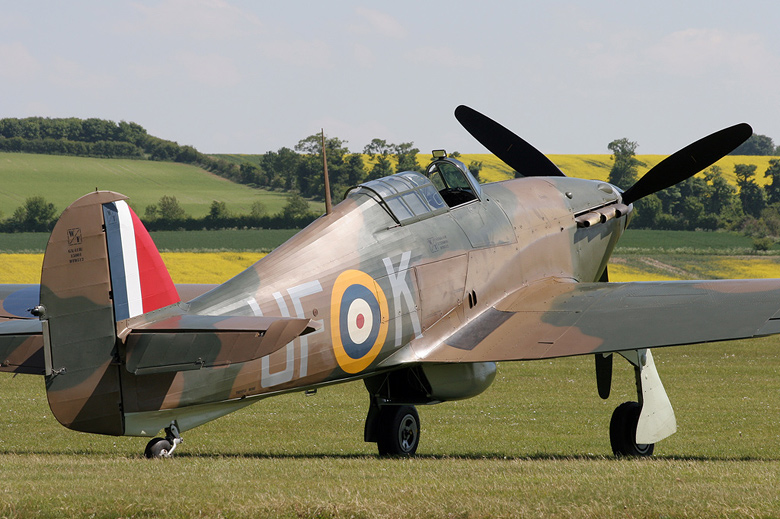
In the midst of the Battle of Britain on August 16 1940, his Hurricane was hit by a German gunner, rupturing the reserve fuel tank and cutting the engine. He nursed his stricken aircraft back to Tangmere whilst the airfield itself was under attack from German bombers. After crash-landing, the fuel tank exploded on the ground, trapping him inside the aircraft. Although he was extracted, he had suffered severe burns and died unexpectedly of shock just two days later at the Royal West Sussex Hospital.
Billy's tombstone at St Mary and St Blaise churchyard in Boxgrove, Sussex, bears the epitaph 'He died for England'.
Flying Officer Davis began his time in the RAF flying the Bristol Blenheim, and his first combat experience was during the Borkum Raid, in which an attacking force of six aircraft launched a surprise assault on a Luftwaffe base on the Frisian Islands, destroying five seaplanes.
601, the so-called 'millionaires squadron', began re-equipping with the Hurricane during March 1940 and Carl Davis went on to make the first of his nine-and-a-half combat kills on July 11 1940, bringing down a Messerschmitt Bf110. A Double Ace, he was awarded the Distinguished Flying Cross during August of the same year.
His final sortie came on the morning of September 6, 1940. After 12 frantic weeks of operations, 601 were scrambled on their final sortie before taking leave when they were intercepted by Bf109s in the skies above Kent. Carl's Hurricane was one of four lost in the fight, crashing into the village of Matfield. An eye witness, Eric W Hubbard, described the scene in a letter to Davis' wife: "I was the first to enter the cottage garden and saw him sitting in his place, with his feet on the rudder bar and the belt still fastened round his waist, clearly showing that he had not moved again after being attacked. I placed a covering over him."
Both pilots were aged 29.
Supermarine Spitfire Mk I
Built at the Westland facility in Yeovil, Supermarine Spitfire AR213 is the second aircraft to have been repainted for the Eagle Squadron. One of the last Mk I variants produced, this aircraft never saw combat and in its new colours masquerades as a Mk IIA, serial number P7308 coded XR-D, which was flown from RAF North Weald by Pilot Officer William R. Dunn of 71 'Eagle' Squadron, RAF Volunteer Reserve.
An infantryman in both the US and Canadian armies, Dunn was determined to fly and his opportunity came when the RAF were looking to the Commonwealth for pilots during the Battle of Britain. Dunn was accepted into the RAF in December 1940, having 'embellished the truth' on his application form by more than trebling his real number of flying hours to meet the minimum experience requirement.
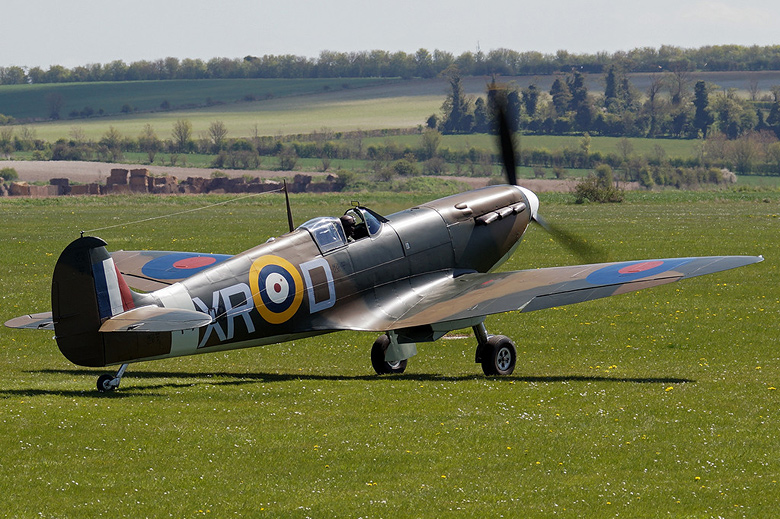
Flying Hurricanes initially, Dunn claimed his first kill in July 1941, making him the first Eagle Squadron pilot to down an enemy aircraft. Transferring to Spitfires later that month, he became the first American ace of the war, claiming two Bf109 kills on August 27th to add to an existing tally of four from previous aerial combat (and a pair of Stukas with anti-aircraft fire while he was serving with the Canadian ground forces!).
It was during that same sortie that he reached ace status, whilst providing top cover to a flight of nine Blenheims that were tasked to bomb the steel plant on the outskirts of Lille, that he and his aircraft were badly damaged by a yellow-nosed Bf109F from Jagdgeschwader (JG) 26. The port wing was ripped and shot up, and a 20mm canon shell had penetrated the left side of the fuselage, shattering the cockpit instruments. Bullets also ripped through his right calf. The toes of his right foot had been blown off and blood was flowing from his head, from a machine gun bullet that doctors later tell him glanced his skull.
Wounded, and with his aircraft in a bad way, man and machine managed to limp back across the channel to make a mayday call, after which two Spitfires escorted him to land at RAF Hawkinge, near Folkstone. Doctors managed to save his foot, but his injuries kept him in hospital for three months. He only returned to his Squadron to pick up his belongings before returning to America.
By March 1944, he was back in England, posted to the 406th Fighter Group of the 9th Air Force, flying a 'Razorback' P-47D out of RAF Ashford. He survived the war and went on to serve in Vietnam before eventually retiring from the Air Force, ranked Lieutenant Colonel, in February 1973. Bill Dunn died on February 14, 1995.
Republic P-47G Thunderbolt
The Fighter Collection's P-47G Thunderbolt arrived at Duxford in 2006, before undergoing an extensive restoration. The aircraft is now a familiar sight at Duxford airshows, having made its debut at Flying Legends 2012. A rare machine - one of only two remaining airworthy 'Razorback' examples licence-built by Curtiss in Buffalo, New York - she wears the markings of the 84th Fighter Squadron, as part of the 78th Fighter Group based at RAF Duxford in late 1944.
Specifically, 'Snafu' (a sarcastic military expression which, phrased politely, means 'situation normal: all fouled up') was the aircraft assigned to Lieutenant Severino B. Calderon. Calderon enlisted to the Air Force in 1942 and survived the conflict, although he later lost his life, aged 25, in an accident whilst flying P-51 Mustangs with the 56th Fighter Group.
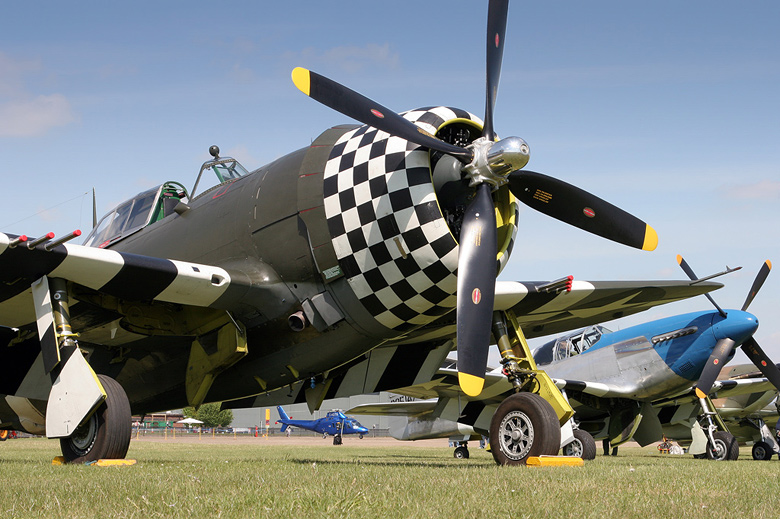
The aircraft is also emblazoned with the "War Eagle" artwork of it's previous pilot, Colonel J Patrick Maxwell.
Maxwell enlisted to the Army Air Corps in 1941, and was posted to the 78th FG at Duxford. He completed a total of 133 combat sorties from UK soil, mostly providing escort cover to the B-17 Flying Fortresses and B-24 Liberators that populated the East of England in vast quantities. In support of the Normandy landings of 1944, Maxwell flew ground attack missions, bombing and strafing targets in Northern France.
The arrival in of the US Forces in England was a pivotal in changing the course of the Second World War, and like many other fighter units across the region, missions of that nature were typical of those undertaken by the 78th FG. Amongst their many achievements, the distinctive black and white chequerboard nosed aircraft of the 'Duxford Eagles' claimed a jet kill when they downed an Me262, and for their part in Operation Market-Garden they were awarded a Distinguished Unit Citation, albeit at a heavy cost.
Maxwell went on to serve in the Korean conflict and by the time he retired from the Air Force in 1963 he was a highly decorated pilot, awarded a Distinguished Flying Cross among many other accolades.
North American P-51C Mustang
'Princess Elizabeth' is an aircraft that will be familiar to Duxford regulars from her time based at the airfield. Restored to flying condition at the IWM by The Fighter Collection over a period of many years, she flew in 2005 and remained in the UK until early 2007, when the aircraft was sold to a new owner in America.
This rare, razorbacked 'Charlie' marque of the P-51 family returned to the UK especially for the Eagle Squadron flights, shipped across in a container and rebuilt in the weeks leading up to the Spring Air Display. The livery represents the personal mount of 1st Lieutenant William T Whisner Jr, an American Air Force pilot flying with the 487th Fighter Squadron, 352nd Fighter Group from RAF Bodney. Flying the only unnamed Mustang on the Squadron, the 'Princess Elizabeth' markings were forced upon him in anticipation of a visit from Elizabeth II. The original airframe was lost in operations on D-Day, downed over France by ground fire, although Whisner wasn't at the controls on that occasion.
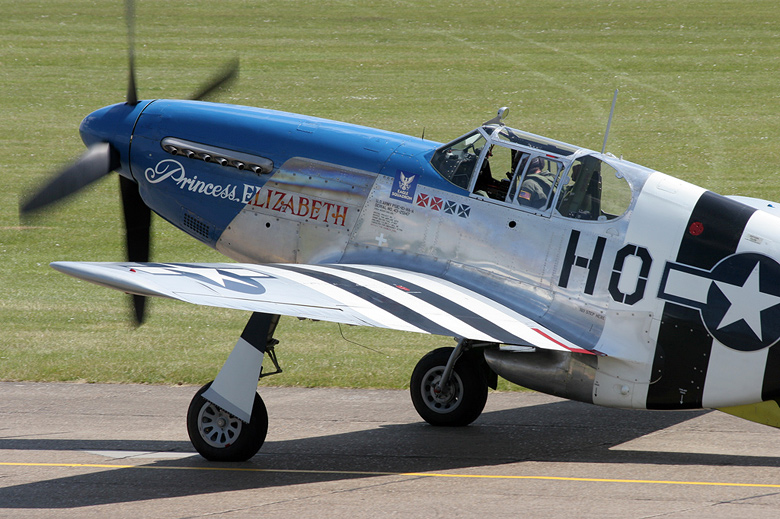
Whisner began his time in the UK whilst the 487th FS were still flying P-47s on short patrols and sorties providing bomber escort. Despite the limitations of the P-47 for this role, Bill made the first of his many kills during this time, shooting down a Focke-Wulf Fw 190 over Belgium which had itself had just claimed one of the B-17s his unit were sent up to protect.
The switch to the P-51 Mustangs in March 1944 improved the fortunes of not just Whisner, but his entire Squadron and by May's end he was an ace, with a count of six victories and one shared.
By the end of the War, Whisner was a highly decorated pilot. His first Distinguished Service Cross (DSC) was awarded for an outstanding performance on November 21 1944; set upon by a number of Fw190s, Bill - flying 'Moonbeam McSwine' - was credited with six kills and two probables on a day that saw "Blue Nosed Bastards of Bodney" claim 23 kills with no losses.
His actions on New Year's Day 1945, during "The Battle of the Bulge", earned him a second DSC. The 362nd Fighter Group were detached to Asch airfield in Belgium when their base came under attack from Bf109s and Fw190s. P-47s and P-51s scrambled into the air, and Whisner, flying 'Moonbeam McSwine' again, almost immediately claimed an Fw190. As he watched the aircraft plummet to the ground, his aircraft was hit. 20mm rounds had punched several holes in his wings, left aileron and oil tank. The rugged Mustang was still able to fly on, and seeing no reason to bug out over friendly territory, Whisner continued into the fierce encounter, claiming another 190 and a pair of 109s. Badly damaged, and with a windscreen covered in oil, Bill and his aircraft recovered back to the airfield.
Bill Whisner ender the War with a tally of 15 and-a-half victories, placing him firmly inside the top 20 American aces of the European Theatre. His military career continued on into the Korean War, where he again reached Ace status; one of only seven pilots to do so in both the Second World War and Korean War. The honours continued also, and he was awarded a third DSC for actions in Korea before retiring as a Colonel from the USAF.
The Commemorative Flypast
The plan for Monday was perhaps of greater significance than the salute in front of a packed crowd the previous day, particularly given the company they would be keeping in the air. The Eagle Squadron were to be joined by B-17 Flying Fortress 'Sally B' and TF-51D Mustang 'Miss Velma', in which US Army Air Force veteran Colonel Clarence Emil "Bud" Anderson would be taking a back seat ride.
Col. Anderson was a triple ace during the war, serving two combat tours with the 363rd Fighter Squadron of the 357th Fighter Group, based at RAF Leiston near the Suffolk coast. Piloting his famous P-51 Mustang 'Old Crow', serial number 44-14450 coded B6-S, Bud completed 116 missions and ended the war with a total of 16 and-a-quarter aerial victories against Bf109s and Fw190s, with another aircraft destroyed on the ground.
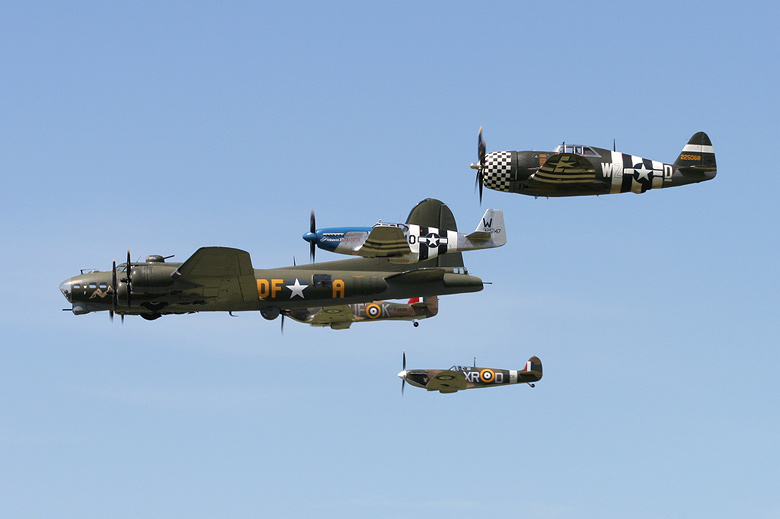
He stayed with the Air Force after the war, serving in post-war Korea and the conflict in Vietnam, flying a number of jet types on operational and test flight duties until his retirement in March, 1972. He was decorated 25 times for his services to the United States, including two Legions of Merit, five Distinguished Flying Crosses, the Bronze Star, sixteen Air Medals, the French Légion d'Honneur and the French Croix de Guerre.
The weather was perfect, as it had been all weekend, and the warbirds of the formation took off on schedule, 'Sally B' and her 'Little Friends' ascending from Duxford's two runways just before noon.
After a flypast at Duxford, the first of the twelve remaining waypoints for the formation was the former bomber base at Bassingbourn. A few miles west of Duxford, Bassingbourn was home to the B-17s of the 91st Bomb Group, amongst which was the iconic 'Memphis Belle' - markings, of course (albeit with the more polished, movie-style nose-art), that 'Sally B' still carries on her starboard side.
Each of the remaining locations had a strong connection to the American airmen of the Eagle Squadrons, the fighters and bomber pilots of the Eighth Air Force and in the case of RAF Mildenhall, the modern day United States Air Forces in Europe. Flypasts at both Bodney and North Weald reiterated the connections to the paint schemes worn by the Spitfire and Mustang, and overhead Leiston, Pete Kynsey, at the controls of 'Miss Velma', broke away from the formation, allowing Colonel Anderson a few moments overhead his former home base in a Mustang once more.
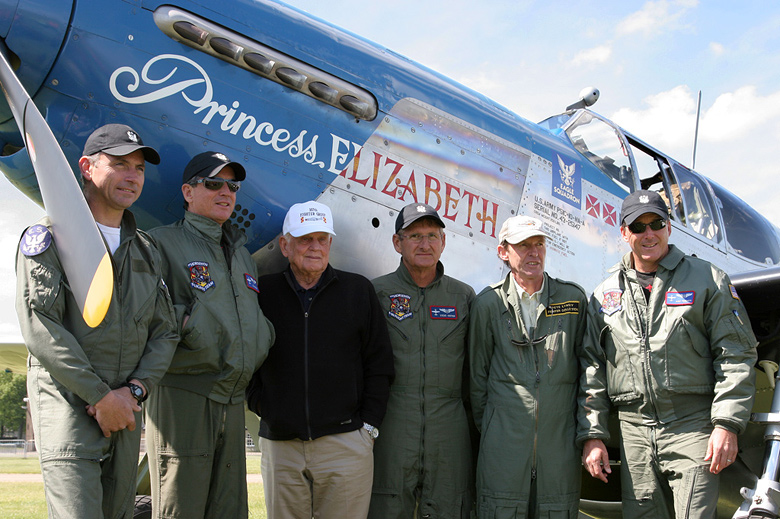
The Eagle Squadron (L-R): Paul Bonhomme (Hurricane), Ed Shipley (P-51C), "Bud" Anderson, Steve Hinton (P-47), Pete Kynsey (TF-51D) & Dan Friedkin (Spitfire).
A missing man formation conducted overhead a memorial ceremony at the American cemetery at Madingley was a moving tribute to each and every one of the American Eagles who gave their lives in the European Theatre of Operations during the Second World War.
